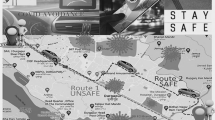Abstract
Over the last two years, the Korean Expressway Corporation (KEC) has developed a location-based dynamic route guidance system. The targets of the new system are the users of mobile-phones, the internet, and PDAs (Personal Digital Assistant), etc. Spatially the system covers 2,804 km of expressway and 484 km of national highway where the travel time collection systems are installed. The developed routing system is in many aspects different from the existing telematics-related services in Korea. It is based on predicted traffic information rather than real-time traffic information, and provides web and location based in-vehicle route guidance system. It utilizes GML (Geographical Markup Language) and GIS (Geographical Information System) in order to create GML DB (Data Base), and follows the standard format of the ISO (International Standard Organization) for GDF (Geographic Data File). Initial results of the proposed system including the accuracy of route travel time forecasts and the soundness of suggested routes were found to be acceptable. After development, the KEC has successfully tested a pilot service of the new system and is currently preparing for a full-scale implementation.
Similar content being viewed by others
References
Boyce, D. (2002). “A memoir of the advance project.” ITS Journal, Vol. 7, No. 2, pp. 105–130.
Chien, S. and Chen, M. (2001a). “Determining the number of probe vehicles for freeway travel time estimation using microscopic simulation.” Transportation Research Record, No. 1719, pp. 61–68.
Chien, S. and Chen, M. (2001b). “Dynamic freeway travel time prediction using probe vehicle data: Link-based vs. path-based.” Transportation Research Record, No. 1768, pp. 157–161.
Chien, S. and Kuchipudi, C. M. (2003). “Dynamic travel time prediction with real-time and historic data.” ASCE Journal of Transportation Engineering, ASCE, Vol. 129, No. 6, pp. 608–616.
Chu, L., Oh, J., and Recker, W. (2005). “Adaptive Kalman filter based freeway travel time estimation.” 84th Annual Meeting Transportation Research Board, Preprint CD-ROM, Washington, D.C.
Demers, A., List, G. F., Wojtowicz, J., Kornhauser, A., Wallace, A., Lee, E. E., and Salasznyk, P. (2006). “Experimenting with real-time ATIS: Stepping forward from ADVANCE.” Proc. of Applications of Advanced Technology in Transportation 9th Int. Conf., Chicago, Illinois, USA, pp. 325–330.
Fu, L. and Rilett, R. L. (1998). “Expected shortest paths in dynamic and stochastic traffic networks.” Transportation Research-Part B, Vol. 32, No. 7, pp. 499–514.
Hoffman, C. and Janko, J. (1990). “Travel times as a basic of the LISB guidance strategy.” Proc. of IEEE Road Traffic Control 3rd Int. Conf., London, U.K., pp. 6–10.
Kim, D., Park, D., Rho, J., Baek, S., and Namkoong, S. (2007). “A study on the construction of past travel time pattern for freeway travel time forecasting — Focused on loop detectors.” International Journal of Urban Sciences, Vol. 11, No. 1, pp. 14–29.
Korea Expressway Cooperation. (2005). Development of location-based dynamic route guidance system, Final Report, Gyeonggi, Korea.
Lam, S. and Toan, T. D. (2008). “Short-term travel time prediction using support vector regression.” 87th Annual Meeting Transportation Research Board, Preprint CD-ROM, Washington, D.C.
Lshak, S. and Al-Deek, H. (2002). “Performance evaluation of short-term time-series traffic prediction model.” ASCE Journal of Transportation Engineering, ASCE, Vol. 128, No. 6, pp. 490–498.
Park, D. and Rilett, L. R. (1998). “Forecasting multiple-period freeway link travel time using modular neural networks.” Transportation Research Record, No. 1617, pp. 163–170.
Park, D. and Rilett, L. R. (1999). “Forecasting freeway link travel times with a multilayer feedforward neural network.” Computer-Aided Civil and Infrastructure Engineering, Vol. 14, No. 5, pp. 357–367.
Park, D., Rilett, L. R., and Han, G. (1999). “Spectral basis neural networks for real-time travel time forecasting.” ASCE Journal of Transportation Engineering, ASCE, Vol. 125, No. 6, pp. 515–523.
Park, D., Sharma, S. L., Rilett, L. R., and Chang, M. (2002). “Identifying multiple and reasonable alternative routes: Efficient vector labeling approach.” Transportation Research Record, No. 1783, pp. 111–118.
Pattanamekar, P., Park, D., Rilett, L. R., Lee, J., and Lee, C. (2003). “Dynamic and stochastic shortest path in transportation networks with two components of travel time uncertainty.” Transportation Research-Part C, Vol. 11, No. 5, pp. 331–354.
Rice, J. and Zwet, E. (2001). “A simple and effective method for predicting travel times on freeways.” Proc. of 2001 IEEE Intelligent Transportation Systems Conf., Oakland, CA, USA, pp. 227–232.
Schrader, C. C., Kornhauser, A. L., and Friese, L. M. (2004). “Using historical information in forecasting travel times.” 83th Annual Meeting Transportation Research Board, Preprint CD-ROM, Washington, D.C.
Shi, X., Hu, J., Xu, Y., and Song, J. (2005). “A simulation study on agent-network based route guidance system.” Proc. of the 8th Int. IEEE Conf. on Intelligent Transportation Systems, Vienna, Austria, pp. 263–268.
Yamashita, T., Izumi, K., and Kurumatani, K. (2004). “Car navigation with route information sharing for improvement of traffic efficiency.” Proc. of 2004 IEEE Intelligent Transportation Systems Conf., Washington, D.C., USA, pp. 465–470.
Zhang, X. and Rice, J. A. (2003). “Short-term travel time prediction.” Transportation Research-Part C, Vol. 11, No. 3–4, pp. 187–210.
Author information
Authors and Affiliations
Corresponding author
Rights and permissions
About this article
Cite this article
Park, D., Kim, H., Lee, C. et al. Location-based dynamic route guidance system of Korea: System design, algorithms and initial results. KSCE J Civ Eng 14, 51–59 (2010). https://doi.org/10.1007/s12205-010-0051-6
Received:
Accepted:
Published:
Issue Date:
DOI: https://doi.org/10.1007/s12205-010-0051-6




